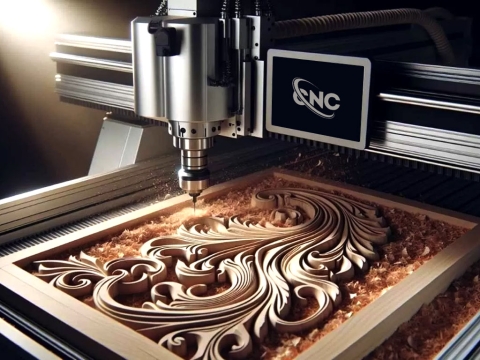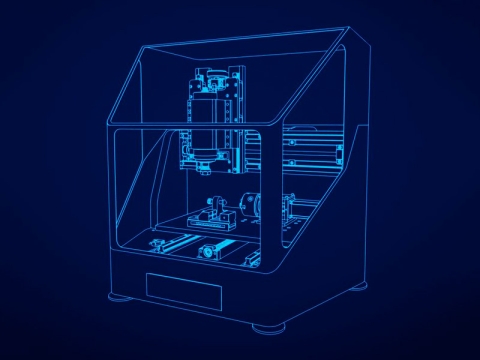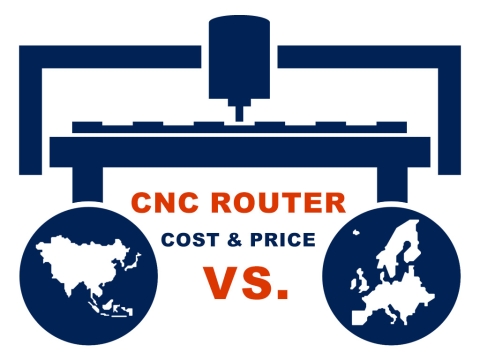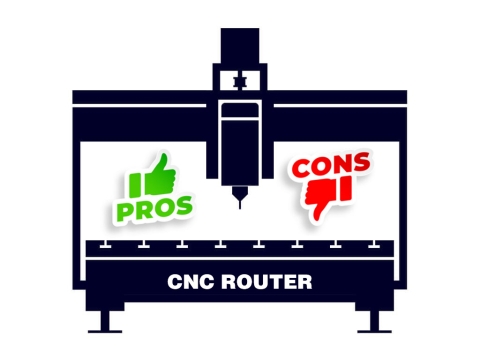
Introduction
This article provides practical guidance on safe working practices when using CNC routers and CNC machining centers, and hand-fed/integrated-fed routing machines. It is aimed at employers and others who have control of how these machines are used. Machine operators will also find this information of use.
Accident history
The woodworking industry has one of the highest rates of accidents caused by contact with moving machinery. The majority of these are because of operator’s hands or fingers making contact with the rotating cutters. Analysis of accidents investigated by STYLECNC has found that the most common causes were:
1. inadequate or missing guards;
2. inadequate or lack of operator training.
Training and information
It is important that the machine is fitted with the necessary safeguards and machine operators are trained to use them and carry out the work they are expected to do safely. Training is particularly important for those involved in maintenance, setting and cleaning to ensure that these activities are undertaken in a safe manner. No one should be allowed to work at a woodworking machine unless they have demonstrated competence. It is advisable that competent operators are authorised in writing by a responsible person (director, senior manager etc). This will then form part of the training records. Anyone who supervises the use of work equipment must also have received adequate training and both operators and supervisors must have access to information and where appropriate, written instructions.
Legal requirements
Legal requirements covering the use of these machines are contained in Safe use of woodworking
machinery. Provision and Use of Work Equipment Regulations 1998 (PUWER) as applied to woodworking machinery. This document gives practical advice on the safe use of woodworking machinery and covers the provision of information and training as well as aspects of guarding and maintenance.
When buying a new machine, it should be supplied with a declaration of conformity and have a CE mark. Designers and manufacturers must conform to the essential safety requirements of the Machinery Directive and associated European Free Trade Association (EFTA) regulations.
Risk assessment
There are many different machine designs with varying degrees of complexity. All machines should be installed to the manufacturer’s specification with the correct services provided. This should include having sufficient extraction for the removal of chips and dust. Never modify a machine in any way unless you have first consulted with the manufacturer/supplier and received confirmation that the modification will not be detrimental to the safety/integrity of the machine. Each machine has its own characteristics and configuration which you should take into account when identifying the hazards and assessing the risks. You will need to consider the following hazards:
1. ejection of the workpiece or cutter – make sure that they are secure before starting;
2. contact with rotating cutters and automatic tool changers (where fitted);
3. trapping and crushing caused by moving tables or machining heads;
4. unexpected movement or start-up caused by faults in the control system;
5. excessive noise emission;
6. the production of dust and chippings;
7. automatic handling and loading devices (where fitted);
8. pneumatic and vacuum clamping devices (where fitted);
9. safe programming of cutting tool rotation and approach speeds compatible with the material being processed;
10. any new programmes should have a ’dry run’ at slow speed in case of any mistakes, to avoid collisions etc.

Figure 1a
Small overhead/C-frame CNC router with fixed distance guard. The risks from any crushing or trapping hazard between fixed and moving machine parts must also be controlled.

Figure 1b
C-frame/cantilever arm machine with pressure sensitive bumpers.
CNC routers and CNC machining centers
CNC routers and CNC machining centers have two main categories:
1. C-frame/cantilever arm/overhead;
2. Portal frame (gantry/goalpost).
C-frame/cantilever arm/overhead
These machines, sometimes referred to as overhead routers, have a single or multifunction head unit mounted on a C-frame/cantilever arm that either moves across the table or remains stationary while the work table moves underneath it, see Figures 1a, b and c.

Figure 1c
C-frame/cantilever arm machine with safety mats.
Portal frame (gantry/goalpost)
These machines have a single or multifunction head unit mounted on a portal frame (gantry/goal post) which can move over the work table or remain stationary while the work table moves underneath it, see Figure 2.

Figure 2
Portal (gantry/goalpost frame) machine with partial enclosure and light barrier.
CNC machining center applications could include routing, vertical and horizontal boring, grooving and shaping applications. These are all served by a multi-position tool changer mounted adjacent to the head unit or placed on the frame of the machine, see Figure 2. It is important that the correct tool is used, suitable for the machine and the application. Tools should also be maintained in good condition.
The majority of machines operate in three axes, X and Y (horizontal movement) and Z (vertical movement). Some machines have the facility to operate with vertical and horizontal rotational axis (five axis machines) and all of these axes will need to be taken into account in the risk assessment. This is especially important for dust and chip collection and the trajectory of ejected waste fragments from the workpiece.
Safeguarding
CNC routers can be guarded by a variety of fixed guards but any safety distances should comply with standards. If the fixed guards are to be demounted by the user for maintenance or cleaning purposes etc, then their fixing systems should remain attached to the guard or to the machine when the guard is removed, eg be fitted with screws that remain attached to the guard.
However, as the control systems on routers have developed from manual control to CNC, the degree of operator intervention during the machining process has decreased. The addition of automatic loading and unloading facilities and automatic tool changing has further reduced the need for close approach to the cutting area. This has allowed manufacturers to adopt safeguarding methods that differ from the close guarding traditionally used on older, manually operated machines.
On large machines it is normal practice to prevent access to the cutting area during the machining process by an enclosure, see Figure 3. The purpose of the enclosure is to prevent:
1. access to the danger zone;
2. the ejection of part of the tool;
3. any crushing or trapping hazard between fixed and moving machine parts.

Figure 3
CNC machining center inside full enclosure.
Access into the enclosure is normally required for:
1. loading or unloading the workpiece;
2. cleaning, setting or adjustment;
3. tool changing.
Where entry into an enclosure is necessary then it should be via an interlocked door that will prevent access while the cutters and other dangerous parts are moving. Any interlocks used should comply with standards. Enclosure requirements include:
1. providing protection up to at least 1.8 m from the floor level;
2. being made of impact-resistant materials capable of containing ejected workpieces or machine components;
3. having audible or visual warning (eg a yellow light) of impending start up;
4. having an emergency stop device (inside the enclosure) that will stop start-up if necessary; ■ having a control device to reset the interlocking of the door that complies with standards. This should be located outside the enclosure but in a position that allows a clear view of the inside. It should not be reachable from within the enclosure;
5. having noise reducing features where machines produce noise levels greater than 85 dB(A).
Other safeguards can be used instead of a full enclosure, such as:
1. partial enclosures, with or without light barriers/ beams (Figure 2);
2. pressure sensitive bumpers (Figure 1b);
3. pressure sensitive mats (Figure 1c).
The choice of safeguards chosen will be dependent on the manufacturer’s/designer’s assessment to ensure that the essential safety requirements of the Machinery Directive and associated European Free Trade Association (EFTA) regulations have been met.
If there are any openings then curtains should be used to protect against the risk of ejection of parts of tools or parts of the workpiece. They should therefore be capable of passing an impact test that holds a 100 g projectile when hit at a speed of 70 m/s.
Where infrequent access is required, for example, just for maintenance operations, then a fixed guard can be used (Figure 1a). This is provided the necessary steps have been taken to prevent an accidental start-up while the machine is being worked on (see’Maintenance’).
There should also be effective local exhaust ventilation (LEV) that is integral with the machine to remove dust and chippings.
Braking
There should be an automatic electrical brake provided for the tool spindle(s) so that they stop within ten seconds.
Tool changing mechanism
In some cases, the enclosure for the cutting area will prevent contact with the tool changer. In other cases there may be a tool magazine that is separate from the machining area and has its own access door. Such access doors should be interlocked with the tool changer and if there is access to the cutters, also interlocked with them. During manual tool changing, there should be no risk of rotation of the tool holder while tools are being inserted or removed. Use either ‘hold-to-run’ or single-step pendant controls to index the tool holder (see also ‘Mode selection switch’).
Maintenance
All safety devices should be checked by a suitably trained and competent person (someone with the necessary skills, knowledge and experience) at regular intervals. This should take into account how much the machine is used as well as any supplier’s or manufacturer’s recommendations. Record the details of any maintenance and inspection checks and in particular any actions identified and confirmation that they have been completed.
Some maintenance may require the machine to be safely isolated to avoid accidental start-up. Safe electrical isolation means that electrical energy is switched off, and there are also suitable precautions to ensure that it remains switched off. Inadvertent reconnection must be prevented – for example by breaking the 3-phase by mechanical means and having a locking-off facility.
Mode selection switch
Where machines are designed to be operated during setting with the moveable interlocked guards and/or protective devices disabled, a mode selection switch must be provided to select between the machining and setting modes of operation. In machine setting mode of operation, if the moveable guards are open and/or protective devices disabled, any hazardous movement should only be possible when several requirements have been met, including:
1. spindle rotation and single axis movement are controlled by a hold-to-run control/enabling device;
2. the single axis movement should be limited to 2 m/min speed or 10 mm increment;
3. if tool rotation is provided it should be limited to a maximum of 300 revolutions/min and tool rotation should stop in less than two rotations after the release of the hold-to-run control.
Hold-to-run control devices and enabling devices for tool or axes movements should be located on the main control panel and/or on a mobile set of controls connected to the machine by a fixed cable or wireless (if provided).
Hand-fed/integrated-fed routing machines
These are overhead/C-frame type machines with a single tool spindle/work head located above a table. The table can be capable of moving in up to three directions (X, Y and Z). Running speeds can vary from 6000 rpm to 24 000 rpm. The workpiece is normally fed to the machine in a direction opposite to the direction of the tool spindle. This can either be manually such as on some older machines, see Figure 4, or with an integrated workpiece feed system where the workpiece is held and controlled mechanically during the machining operation.
Guarding the tools
Ring guard

Figure 4
Manually operated overhead/C-frame router with ring guard that has option for tool changing.
There should be an adjustable and self-closing ring guard fitted that will prevent access to the tool from above and from the sides. The ring guard should rest on the workpiece during machining and its lower surface should remain parallel to the table. It can either be made from one piece or consist of a pressure ring in combination with an enveloping guard that allows for tool changing, eg by means of a noninterlocked hinged cover which is capable of being locked manually in the closed position, see Figure 4. To minimise the risk of ejection, the ring guard should apply a force of between 50N and 150N to the workpiece.
The internal diameter of the ring guard should allow the tool with the largest diameter for which the machine is designed to be mounted. However, if the maximum diameter of the tool exceeds 80 mm, then there should be at least two ring guards with different internal diameters. The ring guard should have a connection to the local exhaust ventilation and be manufactured from either:
■ steel with a wall thickness of at least 1.5 mm;
■ light alloy with a wall thickness of at least 3 mm;
■ polycarbonate with a wall thickness of at least 3 mm;
■ other plastic material having an impact strength at least equal to or better than that of 3 mm polycarbonate;
■ cast iron with a wall thickness of at least 5 mm.
Ring guard support The ring guard support should allow it to move automatically with the spindle head and allow its lower surface to be set parallel to the table, whatever the table position. It should also allow the ring guard to be adjusted so that it can take into account the maximum length of tool that the machine is designed for. Adjustment should be possible without the aid of a tool.
Braking
There should be an automatic electrical or mechanical brake provided for the tool spindle so that it stops within ten seconds.
Tooling
Any router cutters used on single-spindle hand-fed/ integrated-fed routing machines that are over 16 mm in diameter must be of a chip limitation type.





